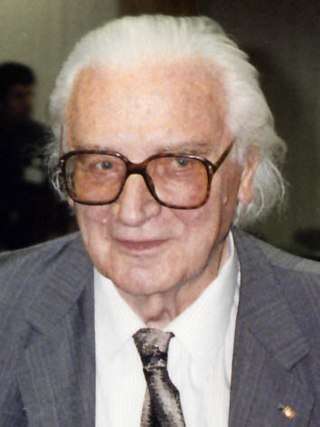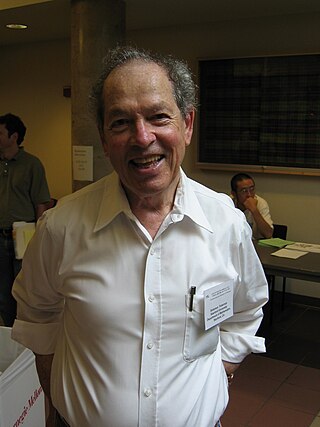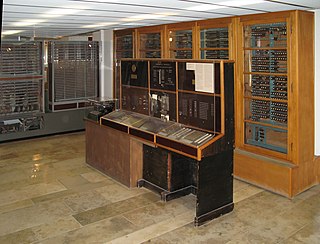
Konrad Ernst Otto Zuse was a German civil engineer, pioneering computer scientist, inventor and businessman. His greatest achievement was the world's first programmable computer; the functional program-controlled Turing-complete Z3 became operational in May 1941. Thanks to this machine and its predecessors, Zuse is regarded by some as the inventor and father of the modern computer.

The Z3 was a German electromechanical computer designed by Konrad Zuse in 1938, and completed in 1941. It was the world's first working programmable, fully automatic digital computer. The Z3 was built with 2,600 relays, implementing a 22-bit word length that operated at a clock frequency of about 5–10 Hz. Program code was stored on punched film. Initial values were entered manually.

Solomon Feferman was an American philosopher and mathematician who worked in mathematical logic. In addition to his prolific technical work in proof theory, computability theory, and set theory, he was known for his contributions to the history of logic and as a vocal proponent of the philosophy of mathematics known as predicativism, notably from an anti-platonist stance.

Peter Henry Salus is a linguist, computer scientist, historian of technology, author in many fields, and an editor of books and journals. He has conducted research in germanistics, language acquisition, and computer languages.

The Z4 was arguably the world's first commercial digital computer, and is the oldest surviving programmable computer. It was designed, and manufactured by early computer scientist Konrad Zuse's company Zuse Apparatebau, for an order placed by Henschel & Son, in 1942; though only partially assembled in Berlin, then completed in Göttingen in the Third Reich in April 1945, but not delivered before the defeat of Nazi Germany, in 1945. The Z4 was Zuse's final target for the Z3 design. Like the earlier Z2, it comprised a combination of mechanical memory and electromechanical logic.

Neil Immerman is an American theoretical computer scientist, a professor of computer science at the University of Massachusetts Amherst. He is one of the key developers of descriptive complexity, an approach he is currently applying to research in model checking, database theory, and computational complexity theory.
Ingo Wegener was an influential German computer scientist working in the field of theoretical computer science.

Elisabeth (Elly) Dekker is a Dutch astronomer and science historian, specialising in the history of astronomy. She studied theoretical physics and astronomy at Utrecht University. In 1975 she obtained a PhD in astronomy at Leiden University with the thesis Spiral structure and the dynamics of flat stellar systems supervised by Hendrik C. van de Hulst. From 1978-1988 she was a curator of Museum Boerhaave in Leiden and afterwards an independent scholar. From 1993-1995 she was a Sackler fellow of the Royal Museums Greenwich. In 1998 she was awarded the Caird Medal for her work on the globe collection of the National Maritime Museum in Greenwich.
Robert V. Bartlett is an American political scientist, currently the Gund Professor of the Liberal Arts at University of Vermont, previously the Fulbright Distinguished Chair at the Polytechnic University of Turin, the Frank Church Distinguished Professor at Boise State University, Senior Fulbright Scholar at Trinity College Dublin, and a Senior Fulbright Scholar at the Centre For Resource Management at Lincoln University and University of Canterbury, He was educated at Indiana University Bloomington.
Serafina Cuomo is an Italian historian and professor at Durham University. Cuomo specialises in ancient mathematics and the history of technology.
Peggy Aldrich Kidwell is an American historian of science, the curator of medicine and science at the National Museum of American History.
Linda Dalrymple Henderson is an American art historian, educator, and curator. Henderson is currently the David Bruton, Jr. Centennial Professor in Art History Emeritus at the University of Texas at Austin. Her research focuses on modern art, specifically twentieth-century American and European art.
Rosamund Sutherland was a British mathematics educator. She was a professor emeritus at the University of Bristol, and the former head of the school of education at Bristol.
Catherine Lee Westfall is an American historian of science known for her work documenting the history of the United States Department of Energy national laboratories.
Judith Veronica Field is a British historian of science with interests in mathematics and the impact of science in art, an honorary visiting research fellow in the Department of History of Art of Birkbeck, University of London, former president of the British Society for the History of Mathematics, and president of the Leonardo da Vinci Society.
Tara E. Nummedal is a professor of history and Italian studies at Brown University, where she holds the John Nickoll Provost’s Professorship in History. Nummedal is known for her works on Anna Maria Zieglerin and the history of alchemy and natural science in early modern Europe.
Robert Anthony Hyman (1928–2011) was a British historian of computing.
Elizabeth Redding Jessup is an American computer scientist specializing in numerical linear algebra and the generalized minimal residual method. She is a professor emerita of computer science at the University of Colorado Boulder.
Dianne Carol Hansford is an American computer scientist known for her research on Coons patches in computer graphics and for her textbooks on computer-aided geometric design, linear algebra, and the mathematics behind scientific visualization. She is a lecturer at Arizona State University in the School of Computing and Augmented Intelligence, and the cofounder of a startup based on her research, 3D Compression Technologies.
Mary G. Croarken is a British independent scholar and author in the history of mathematics and the history of computing.







